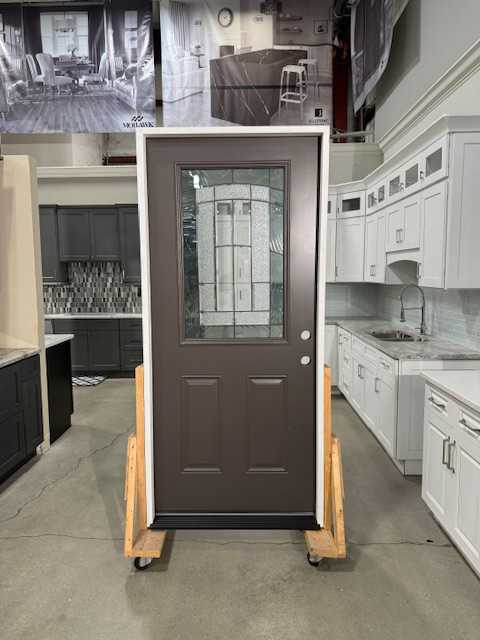What Is a Prehung Entry Door — And Is It Right for Your Home?

When upgrading your home’s entryway, the door you choose can make a big difference. It impacts your home’s curb appeal, security, and energy efficiency. If you're looking into new doors, you might have heard the term prehung entry door.
So, what exactly is a prehung entry door?
A prehung entry door comes fully assembled. It includes the door slab, frame, hinges, and often, the hardware. This makes it a complete unit, ready to be installed in your home. If you're replacing an old door or building a new home, this option can save you time and effort.
The main benefit of a prehung door is convenience. Since everything is preassembled, installation is simpler and faster. You won’t have to worry about adding a door frame or figuring out hinge placement.
But is a prehung entry door the right choice for you? It depends on your needs. We’ll explore the benefits, compare it to other options, and help you decide if it’s the best fit for your home.
What Is a Prehung Entry Door?
A prehung entry door is a door that comes fully assembled. It includes the door slab, the frame (or jamb), hinges, and often hardware like locks and handles. This makes it a complete unit, ready to be installed in an opening.
The prehung door is designed to be fitted into a rough opening in your home. It’s an ideal choice for new constructions, renovations, or when you need to replace both the door and its frame. Unlike a slab door, which is just the door itself and requires you to use your existing frame, a prehung door takes care of both the door and the frame in one go.
The beauty of a prehung entry door lies in its simplicity. Since the door and frame come together, you won’t have to worry about measuring, framing, or attaching the hinges yourself. It’s a faster and more convenient option for homeowners who want a hassle-free installation.
Benefits of Prehung Entry Doors

There are several reasons why prehung entry doors are a popular choice for homeowners. Here are the top benefits:
1. Ease of Installation
Since everything comes preassembled, installing a prehung entry door is much easier and quicker. If you hire a professional, they can usually get the job done in less time. Thus, you are able to save money on labor.
2. Energy Efficiency
Prehung doors are known for their tight seals. The door slab, frame, and weatherstripping are designed to work together. It reduces drafts and improves insulation. This helps to keep your home more energy-efficient and lowers heating and cooling costs.
3. Security
A prehung door often provides better security than other options. The frame is sturdy, and when installed correctly, the door will fit tightly into place.
4. Customization
Prehung entry doors come in a variety of materials, including wood, fiberglass, and steel. You can also choose from different styles and finishes to match your home’s design. Whether you want something classic or modern, there's a prehung door option for every taste.
5. Durability
Since prehung doors come with a full frame, they are less likely to warp or get damaged over time. The complete unit ensures that everything stays in place and functions well. Even after years of use.
In short, prehung entry doors offer convenience, energy savings, and security. They are an excellent choice for homeowners looking for a reliable and easy-to-install entry solution.
Prehung vs. Slab Doors: Which Is Right for You?

You’ll likely come across two main options when choosing a new entry door: prehung doors and slab doors. Though both can be great choices, they serve different needs. Here’s a breakdown to help you decide which is the best fit.
Prehung Doors
A prehung entry door comes with the door slab, frame, and hardware all together. It’s ready to be installed as a complete unit in your home. Prehung doors are perfect if you're working on a new construction project or need to replace both the door and its frame.
Slab Doors
A slab door is simply the door itself, without a frame. If your existing frame is still in good condition, you can use a slab door to replace just the door. Slab doors are usually more affordable, but you’ll need to handle the installation of the frame and hinges yourself, or hire someone to do it for you.
| Feature | Prehung Door | Slab Door |
|---|---|---|
| Includes Frame | ✅ Yes | ❌ No |
| Hardware Included | ✅ Hinges and frame pre-installed | ❌ Requires separate purchase and installation of hinges, handle, and strike plate |
| Installation Complexity | ✅ Easier and quicker installation due to pre-assembled components | ❌ Requires precise carpentry skills for fitting into existing frame |
| Best For | ✅ New constructions, replacing both door and frame, or when existing frame is damaged | ✅ Replacing just the door when the frame is in good condition |
| Cost | ❌ Generally more expensive due to included frame and hardware | ✅ More affordable, but additional costs for hardware and potential professional installation |
| Customization | ❌ Limited to available sizes and styles | ✅ High customization potential, especially for vintage or unique doors |
| Weight & Handling | ❌ Heavier and bulkier, may require two people to handle and install | ✅ Lighter and easier to transport and install |
| Energy Efficiency | ✅ Often better weather sealing, suitable for exterior doors | ❌ May require additional sealing for exterior use |
| Durability | ✅ Sturdy construction with pre-installed hardware | ❌ Dependent on existing frame condition and quality of installation |
| DIY Suitability | ✅ Suitable for DIYers with basic skills | ❌ Recommended for experienced DIYers or professionals due to installation complexity |
When to Choose a Prehung Door:
- You're working on a new construction or major renovation.
- The existing door frame is damaged or warped.
- You prefer a quicker and easier installation process.
- You're replacing an exterior door and require better weather sealing.
When to Choose a Slab Door:
- The existing door frame is in good condition.
- You're on a tighter budget and can handle additional installation work.
- You desire a unique or custom design, such as repurposing a vintage door.
- You're replacing only the door without altering the frame.
How to Install a Prehung Entry Door
Installing a prehung entry door is relatively straightforward, especially compared to other types of door installations. Here’s a step-by-step guide on how to do it:
1. Prepare the Opening
Before you begin, make sure the rough opening for the door is the right size. It should be slightly larger than the prehung door to allow for shimming and adjustments. Check that the opening is square and level to ensure the door fits properly.
2. Position the Door
Carefully place the prehung door into the opening. Make sure it’s centered and aligned correctly. You may need a second person to help hold the door in place.
3. Shim and Secure the Frame
Once the door is in place, use shims to ensure the frame is level and plumb (vertically straight). Insert the shims between the frame and the opening. Then, screw the frame into place through the jambs. Make sure the door swings freely and doesn’t rub against the frame.
4. Install Hardware
Now it’s time to install the lockset, strike plate, and any other hardware. Make sure the hardware fits well and works smoothly.
5. Seal Gaps and Add Finishing Touches
After securing the door, apply a sealant or weatherstripping to fill any gaps around the door frame. This will help improve energy efficiency and prevent drafts. Finally, add any trim or finishing touches to complete the look.
By following these steps, you’ll have your prehung entry door installed in no time!
Is a Prehung Entry Door Right for Your Home?
It depends on several factors. Here are some things to consider:
1. New Construction or Major Renovations
If you’re building a new home or undertaking a major renovation, a prehung entry door is an excellent option. It provides a complete solution that’s easy to install and ensures a high-quality, durable result.
2. Replacing an Existing Door
If your existing door frame is damaged or outdated, a prehung door is a good choice. It allows you to replace both the door and the frame at the same time, ensuring a better fit and improved energy efficiency.
3. Budget and Time Considerations
Prehung doors can be a little more expensive than slab doors, but they can save you time and labor costs during installation. If you’re on a tight budget or need to do the job quickly, consider whether the added convenience is worth the cost.
4. Customization and Design
Prehung doors come in a variety of styles, materials, and finishes, giving you plenty of options to match your home’s aesthetic. Whether you prefer a classic wooden door or a sleek fiberglass model, you can find a prehung entry door that fits your design preferences.
In conclusion, a prehung entry door is a great option if you need a complete, easy-to-install solution for your entryway. It’s a durable, secure, and energy-efficient choice, perfect for new builds, major renovations, or replacing old doors. If you’re unsure, consult with a professional to assess your specific needs and make the best decision for your home.











